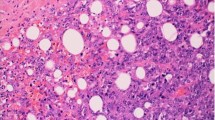Abstract
Background: Many patients treated for breast cancer with radiotherapy will survive their disease and be at risk for treatment-related sarcoma for many years.
Methods: In order to identify patients with post-treatment sarcoma and define this disease, we examined the records of 99 patients treated for sarcoma with a history of antecedent breast carcinoma. Of these patients, 51 were felt to have a sarcoma unrelated to breast cancer treatment and 48 were felt to have a treatment-related sarcoma (secondary to lymphedema and/or radiation).
Results: Lymphangiosarcoma of the extremity was the most common histologic subtype of post-treatment sarcoma, accounting for 22 of 48 cases (46%). Twenty-six patients (54%) developed nonlymphangiosarcoma post-treatment sarcoma; all of these were radiation-associated sarcomas. The median latency interval between the diagnosis of breast cancer and the development of sarcoma was 11 years (range 4–44) and was not different between the two groups. However, patients with nonlymphangiosarcoma were significantly younger when diagnosed with breast cancer than were those with lymphangiosarcoma of the extremity (median 43 vs. 51 years, p<0.001). The survival of all 48 patients was poor: 5-year survival was 29%. Five-year survival of patients with other types of post-treatment sarcoma was just as poor as those with lymphangiosarcoma of the extremity (30% vs. 28%, p=0.98).
Conclusions: Patients who develop sarcoma after treatment for breast cancer have a poor prognosis whether it occurs as Stewart-Treves syndrome or other types of post-treatment sarcoma. Younger patients may be at higher risk than are older patients for the development of nonlymphangiosarcoma post-treatment sarcoma.
Similar content being viewed by others
References
Brady MS, Gaynor JJ, Brennan MF. Radiation-associated sarcoma of bone and soft tissue.Arch Surg 1992;127:1379–85.
Kaplan EL, Meier P. Nonparametric estimation from incomplete observations.Am Stat Assoc J 1958;53:457–81.
Mantel N. Evaluation of survival data and two new rank order statistics arising in its consideration.Cancer Chemother Rep 1966;50:163–70.
Zar JH.Biostatistical analysis. 2nd ed. Englewood Cliffs, NJ: Prentice-Hall, 1984:61–78.
Hajdu SI.Pathology of soft tissue tumors. Philadelphia, PA: Lea & Febiger, 1979:44–5.
Stewart FW, Treves N. Lymphangiosarcoma in postmastectomy lymphedema.Cancer 1948;1:64–81.
Yap B-S, Yap H-Y, McBride CM, Bodey GP. Chemotherapy for postmastectomy lymphangiosarcoma.Cancer 1981;47:853–6.
Sordillo PP, Chapman R, Hajdu SI, Magill GB, Golbey RB. Lymphangiosarcoma.Cancer 1981;48:1674–9.
Woodward AH, Ivins JC, Soule EH. Lymphangiosarcoma arising in chronic lymphedematous extremities.Cancer 1972;30:562–72.
Ferguson DJ, Sutton HG, Dawson PJ. Late effects of adjuvant radiotherapy for breast cancer.Cancer 1984;54:2319–23.
Schirger A. Postoperative lymphedema: etiologic and diagnostic factors.Med Clin North Am 1962;46:1045–50.
Kaufmann T, Chu F, Kaufman R. Post-mastectomy lymphangiosarcoma (Stewart-Treves syndrome): report of two long-term survivals.Br J Radiol 1991;64:857–60.
Valagussa P, Tancini G, Bonadonna G. Second malignancies after CMF for resectable breast cancer.J Clin Oncol 1987;5:1138–42.
Mindell ER, Shah NK, Webster JH. Postradiation sarcoma of bone and soft tissues.Orthop Clin North Am 1977;8:821–34.
Kim JH, Chu FC, Woodard HQ, Melamed MR, Huvos A, Cantin J. Radiation-induced soft-tissue and bone sarcoma.Radiology 1978;129:501–8.
Tountas AA, Fornasier VL, Harwood AR, Leung PMK. Postirradiation sarcoma of bone. A perspective.Cancer 1979;43:182–7.
Souba WW, McKenna RJ, Meis J, Renjamin R, Raymond AK, Mountain CF. Radiation-induced sarcomas of the chest wall.Cancer 1986;57:610–5.
Taghian A, de Vathaire F, Terrier P, Le M, Auquier A, Mouriesse H, Grimaud E, et al. Long-term risk of sarcoma following radiation treatment for breast cancer.Int J Radiat Oncology Biol Phys 1991;21:361–7.
Harvey EB, Brinton LA. Second cancer following cancer of the breast in Connecticut, 1935–1982.Natl Cancer Inst Monogr 1985;68: 99–112.
Kato H, Schull WJ. Studies of the mortality of A-bomb survivors. 7. Mortality 1950–1978: Part I. Cancer mortality.Radiat Res 1982;90:395–432.
Tokunaga M, Land CE, Yamamoto T, Asano M, Tokuoka S, Ezaki H, Nishimori I. Breast cancer in Japanese A-bomb survivors.Lancet 1982;2:924.
Kelly PT.Understanding breast cancer risk. Philadelphia, PA: Temple University Press, 1991:103–17.
Hatlinghus S, Rode L, Christensen I, Vaage S. Sarcoma following irradiation for breast cancer.Acta Radiol Oncol 1986;25:239–42.
Author information
Authors and Affiliations
Rights and permissions
About this article
Cite this article
Brady, M.S., Garfein, C.F., Petrek, J.A. et al. Post-treatment sarcoma in breast cancer patients. Annals of Surgical Oncology 1, 66–72 (1994). https://doi.org/10.1007/BF02303543
Received:
Accepted:
Issue Date:
DOI: https://doi.org/10.1007/BF02303543




